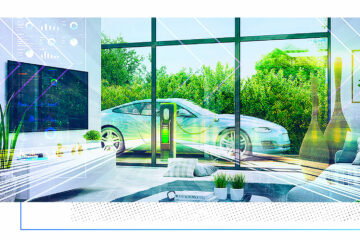To dive deeper into these future-ready trends, hear more from utility leaders at PGE, Pepco, APS, Duke and dozens of others through our on-demand Engage session recordings.
Each year Engage brings together utility industry leaders to share new ideas about how data and AI are transforming operations across the enterprise — from customer engagement to grid management.
This year’s experts explored what it means for a utility to be future-ready as we establish ambitious decarbonization goals and prepare for never-before-seen loads from electric vehicles and the complexity of distributed energy resources.
Throughout the three days of discussion, five key future-ready trends for 2022 emerged.
Trend #5: Customer-Driven Flexible Load Programs Are Essential to Achieve Net Zero
For Portland General Electric (PGE) to reach net zero by 2040, Senior VP of Advanced Energy Delivery Larry Bekkedahl says it will require demand response and creating flexible load with PGE customers. That understanding is what led the electric company to develop its smart grid test bed.
“The smart grid test bed is a program that we developed in coordination with the Oregon Public Utilities Commission and a number of regional stakeholders in the energy and energy efficiency demand response space that affords us the opportunity to experiment with customers on new program design and test products and services that help us expand and increase the impact of our flexible load portfolio,” explains PGE Manager of Customer Technology Development, Tim Treadwell. “One of the main concepts behind the test bed was to get a critical level of customer participation. And in order to do that, the Commission gave us authorization to auto-enroll customers into an opt-out behavioral Demand Response Program, which gave us the opportunity to expose them to DR concepts and the importance of flexibility and managing the grid. We’re using that as a jumping off point to move them into other flexible load products like direct load control, smart thermostats, water heaters and EV charging.”
Treadwell says that in addition to the technology demonstrations, PGE is also exploring new customer value propositions. “We’re framing and presenting back to customers the benefits of flexible load program participation in different ways to see how various demographic groups respond. Our goal is to really understand how customers feel about flexible load and what benefits they see in participation so that we can foster more customized engagement and drive participation.”
Using Bidgely’s Analytics Workbench as a foundation, PGE supercharged the analytics with additional ground truth data to empower the platform to provide deeper insights on specific technologies in use in customer’s homes. The utility is using those appliance insights to align with its flexible load programs.
“Having an enhanced understanding of how customers use electricity is really central to our efforts to manage grid stability and provide reliability,” emphasizes Treadwell. Having a clearer picture of the technical potential of flexible load, and being able to effectively engage customers to capture that load, is critical to our near term goals, and will be essential as we move toward a high-renewable future.”
Trend #4: The Clean Energy Transformation Can Only Be Achieved if Pursued Equitably
Engage featured a lot of discussion about the importance of ensuring that all customers and communities can achieve the benefits and the promise of a clean energy future.
“We’re taking a data-driven approach that we call ‘total marketing’ to ensure that we understand the unique needs of all customers, and that customers who have historically been underrepresented in our programs are able to participate moving forward, says William Ellis, Regional VP of External Affairs at PEPCO Holdings. “We leverage data by examining program participation both demographically and geographically to find out which customers are underrepresented. That includes understanding barriers to participation, whether those barriers are financial, cultural, educational awareness, or even policy decisions that prevent certain pockets of customers from participating. We are actively addressing those barriers to ensure that our most vulnerable customers, those who need our programs the most, are achieving the promised benefits.”
For Arizona Public Service, clean energy equity means ensuring that coal communities are not left behind, as evidenced by $128 million in transition support they have committed to the Navajo Nation as APS prepares to cease coal plant operations. The commitment includes economic development funds, investments in infrastructure and clean jobs.
“Seventy percent of the homes in the United States that don’t have electricity are located on the Navajo Nation. We saw how the lack of access to clean water and electricity allowed COVID to have a greater impact on less privileged communities. So it was very important to us, and frankly, very important to the Navajo Nation, that electrification of Navajo homes be an important component of our commitment, emphasized APS VP of Sustainability Ann Becker. “We also have committed to offer all coal plant employees different jobs within the APS enterprise starting six months before plant closure. And because the Navajo Nation is eager to evolve from a fossil fuel-based economy to a clean energy economy, we have committed to issue RFPs for 600 megawatts of clean energy projects to be located on or near the Navajo Nation.”
Becker recommends that as utilities think about their own exits from their legacy fossil fuel fire generation facilities, they prioritize stakeholder engagement.
“It was really important to us to understand what was important to the Navajo Nation, so we actively engaged with them in the process, as well as with a fairly large group of external stakeholders that included environmental NGOs, community representatives and others to understand what was important from everyone’s perspectives.”
Trend #3: Price Signals and Rate Design Will Figure Prominently in Decarbonization
Duke Energy recognizes that when distributed resources and electric vehicles are deployed at scale, rates must serve as a strategic mechanism to balance the grid.
“In the past, it was a bit of a simpler equation. We had dispatchable, centralized generation capable of meeting variable load,” said Lon Huber, VP, Rate Design and Strategic Solutions at Duke Energy. “But now we have to balance variable load and variable generation while factoring in the complexity of local resources. A two-way pricing mechanism becomes an absolutely must. I’d like to understand from customers where their tolerances are, so I can get the best deal for resources deep in the grid edge.”
Huber emphasized that such an approach marks a shift from today’s reality in which many states have a fixed compensation rate for distributed resources, which is typically the retail rate.
“Retail rates have been lagging behind innovation, because of the lack of metering and billing systems. Now that’s all changing,” Huber said. “It’s changing for Duke as we implement our new billing system to match the capabilities of our new AMI meters. Now we can send better price signals and get feedback, communicate to devices, and almost have a type of bidding structure where resources can participate. And we can do some price discovery so we can make sure we’re getting the best bang for the buck from all these resources down in the distribution system, because at the end of the day, we want to decarbonize, but do so in a way that’s that is has a light impact on customer bills. You want to look at the dollars that you’re paying per ton of C02 emissions. And you’re not going to get that if you just send static rates that are decoupled from competition or from the actual costs of these resources.”
Trend #2: New Economic Approaches Will Advance EV Integration
Utilities agree that managing EV load will require a collaborative effort between electric companies and EV drivers, including EV charging initiatives that are win-win for both parties.
“One idea that we’ve tee’d up is a new tariff that will enable us to offer not only level 2 equipment installation, but also to allow customers to lease the equipment — which puts them on an EV time of use rate,” explains Matt Valle, VP of Development at Florida Power and Light. “What that equates to is roughly $38 a month for unlimited night and weekend charging, which lines up with our time of use rate. We’ve taken a look at the average miles driven in a year and vehicle efficiencies, and we feel like that’s the right starting price point. I filled up my car the other day and it cost more than $70 for one fill up. We’re preparing to offer $38 for unlimited night and weekend charging all month. Your car is full every day. It’s a fixed number. It’s a 10 year contract. We give you controls to monitor usage. It’s very simple.”
Huber added that Duke also recently filed for an electric vehicle tariff. “It’s a new type of infrastructure tariff that allows the customer to participate in the EV revolution without having to pay high upfront costs. It’s essentially a type of subscription for EV charging equipment.”
Duke is also leveraging Analytics Workbench and personalized emails and alerts to assess the effectiveness of ongoing driver engagement featuring monetary incentives and strikes to realize behavior change and desired peak demand reduction. Managed charging and demand response promise to figure prominently in EV load management as adoption grows.
Trend #1: CX Has Become a Mission Critical Necessity
The single most important mega-trend evidenced by the utility insights and predictions described above is that customer experience and customer engagement is no longer a nice-to-have, it’s become a fundamental necessity.
“Utilities have to become more interactive with consumers, and the best way to do that is through data,” advises Bidgely CEO Abhay Gupta. “But you cannot randomly or suddenly tell a consumer, ‘I want to interact with you.’ The only way to successfully interact with consumers is to demonstrate ‘I know this is who you are.’ and ‘I want to offer you something nice.’ In order to know who your customer is, you have to use data. So I would say, utilities who are not using the data, start using the data, and the ones who are using it, use more of it. Learn who your customers are and offer them things that they care about, like saving money and meaningful conveniences.”
“To move from a transactional approach to personalized customer solutions takes data. You need to have the data to understand who the customer is so that you can say, ‘you’re not just a time of day customer, you are a time of day customer who has an electric vehicle,’ or ‘ you’re a time of day customer who has solar,’ whatever it is, and we want to be able to provide you with a customized experience that says, ‘we know you, and we serve you based upon who you are and your family’s needs,” agrees Quisha Light, Manager of Product Development & Lifecycle Management at Portland General Electric. “That’s why we’re working through every product and program that we’re building with the goal to understand how we can teach and educate customers about how they can get the most value for their electricity from the various smart appliances and tools that they have in their home. For that EV customer, it might be when to best charge it and how to earn from it — because we have programs where customers who engage with us and switch their usage away from the peak load period are compensated. Personal energy use data insights are critical, because we need to know what appliances they have in their home so that we can shape experiences based upon what that customer needs, what they how they can best interact with PGE.”
To dive deeper into these future-ready trends, hear more from utility leaders at PGE, Pepco, APS, Duke and dozens of others through our on-demand Engage session recordings.


